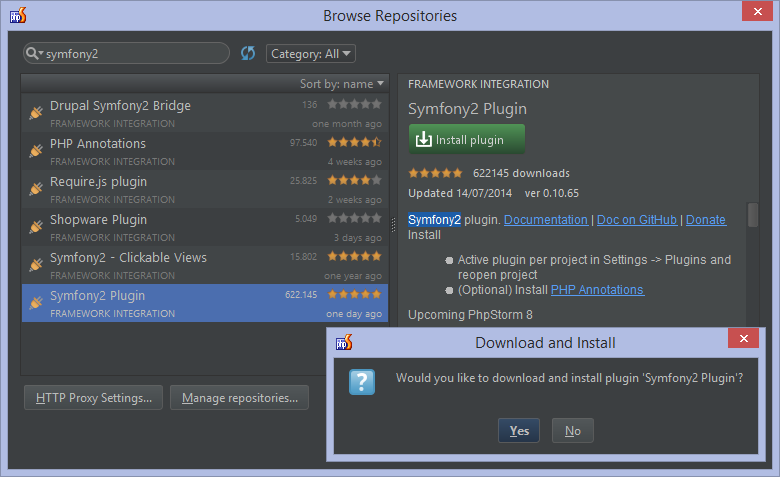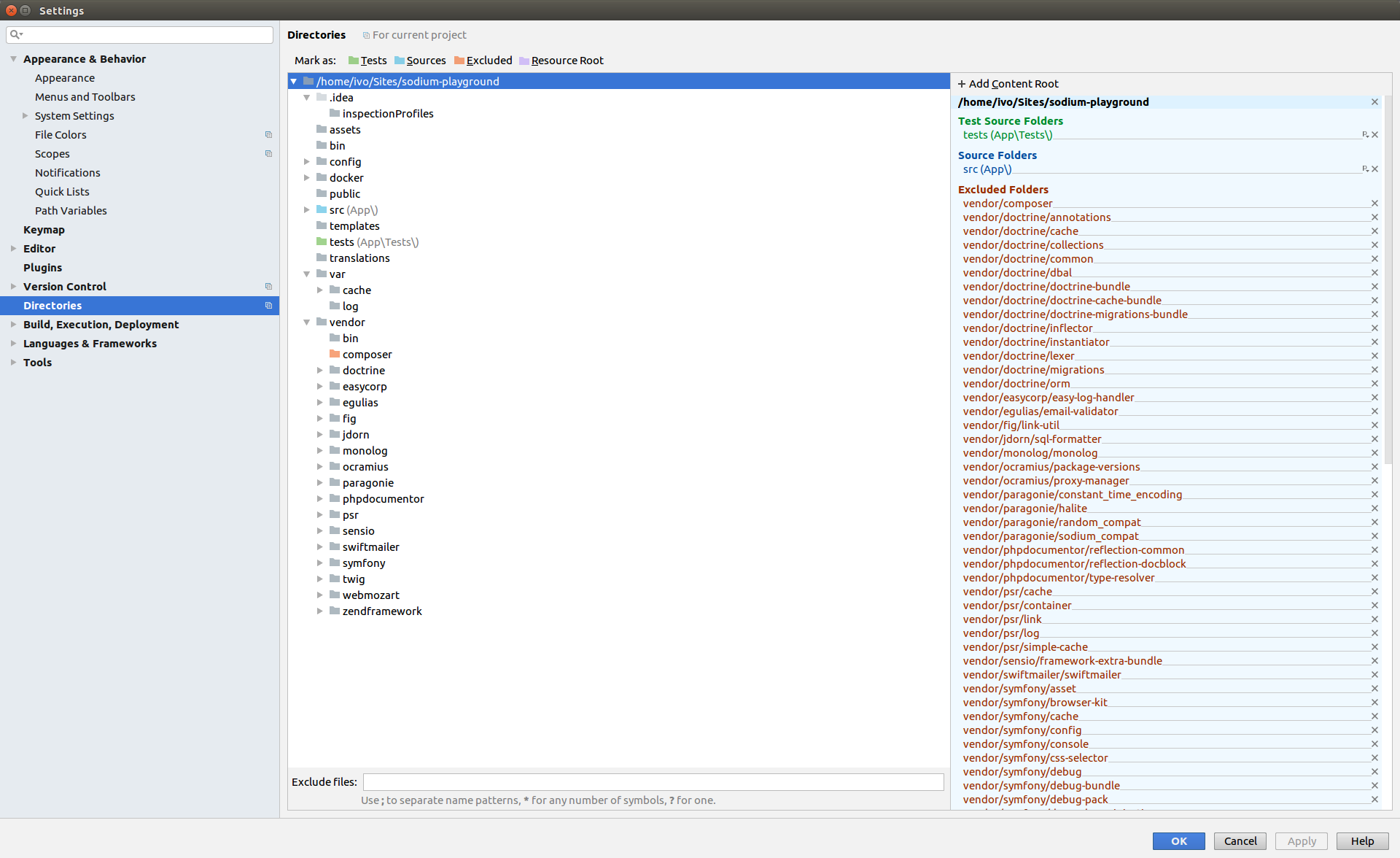SymfonyInsight helps you get back control over your PHP applications, byidentifying flaws and providing support in fixing them during your continuousintegration process, and giving you an objective rating of errors and technicaldebt assessment.

If debugging fails at first, close all of the running PHPStorm services, and try running the Debug Symfony Web-Server (ensuring that PHPStorm is listening for Debug Connections) and then re-launch your browser. For some reason Xdebug may not initialize otherwise, but this behavior is sporadic and hard to reproduce consistently.
However, in order to boost your productivity and streamline your workflow, itwould be better to have the analysis results integrated into the development toolsthat you use on a daily basis. That's why SymfonyInsight now integratesseamlessly with PHPStorm, the leading PHP IDE.
Let’s create a project using the Symfony framework and install dependencies using Composer support in PhpStorm. Creating a new project with Composer When creating a new project in PhpStorm using the File New project menu, we can choose from a list of project types. PhpStorm 6 introduces a new project type: Composer project. TOP 5 plugins for PHPStorm every PHP developer should know. Those plugins will help you bring your coding skills to the next level.1. Key Promoter XThis plug. Cheatsheet for PHPStorm Ideolog Symfony logs format Requirements Setting up Tweaks Critical severity Here is a screenshot of all actions described above. Test case README.md. Color theme for Symfony & Twig used in Visual Studio Code. Author Name: Nahum Rosillo.
Prerequisites¶
This tutorial assumes that you already have a SymfonyInsight account and haveperformed some code analysis. If you haven't, consider reading first theGetting Started tutorial.
In addition, you must have installed PHPStorm version 7 or higher. If you haven't,consider downloading a free evaluation copy from its website.
SymfonyInsight plugin installation¶
1 Open PHPStorm, click on the Settings/Preferences menu, select thePlugins option and click on the Browse repositories button:
2 Select SymfonyInsight plugin from the list and click on theInstall plugin button.
3 Restart PHPStorm for the changes to take effect.
SymfonyInsight plugin configuration¶

Before using the plugin, you must connect it with your SymfonyInsight account:
1 Click on the PHPStorm's Settings/Preferences menu and look for thenew SymfonyInsight configuration section:
2 In the API Settings section, type in your User UUID and yourAPI token. The easiest way to get these values is to click on theOpen SymfonyInsight's dashboard link at the top of this window:
Since these values can be configured from one PHPStorm project to another, checkthe Save as default API settings option to avoid having to introduce thesevalues again for the rest of your projects.
3 Click OK button to save the changes and PHPStorm will now be readyto show you the results of the SymfonyInsight analysis.
Integrating Code Quality Analysis in PHPStorm¶
Selecting the project¶
Generally, your PHPStorm project will point to the same VCS repository used whenadding the project to SymfonyInsight. In this case, PHPStorm will show youthe analysis results right away without any further configuration.
In order to check if the right project is selected, click on the SymfonyInsightpanel at the bottom of the PHPStorm window:
Once clicked, you'll see the project details and a few shortcuts for commonSymfonyInsight actions:
If no project is selected or if you want to choose another project, you'll haveto select explicitly the project being analyzed:

1 Click on the PHPStorm's Settings/Preferences menu and look for theSymfonyInsight configuration section:
2 In the Project on SymfonyInsight section, click on theSelect project button:
3 PHPStorm will show you the list of projects configured in yourSymfonyInsight account. Select the project to analyze and click on the OKbutton to save the changes.
Exploring your SymfonyInsight reports in PHPStorm¶
Now that everything is correctly configured, browse your project's source code andyou'll find new icons in the left gutter of your editor. The yellow puzzle pieceicon is the marker used to alert you about SymfonyInsight violations.
Move your mouse over those icons and you'll see more information about the codequality violation.
Click on the floating window message and you'll be redirected to that exactviolation on SymfonyInsight website, where you'll find all the details aboutthis error.
From time to time, you'll have to synchronize your PHPStorm project to the mostrecent quality report. To do so, click on the SymfonyInsight panel at thebottom of the PHPStorm window and click on the Sync with latest analysis on SymfonyInsightoption.
PhpStorm supports unit testing of PHP applications through integration with the PHPUnit testing framework.
Before you start
Make sure the PHP interpreter is configured in PhpStorm on the PHP page, as described in Configure local PHP interpreters and Configure remote PHP interpreters.
Download and install PHPUnit
Before you start, make sure Composer is installed on your machine and initialized in the current project as described in Composer dependency manager.
Download and install phpunit.phar manually
Download phpunit.phar from the PHPUnit Official website and save it on your computer:
If you need full coding assistance in addition to the ability of running PHPUnit tests, store phpunit.phar under the root of the project where PHPUnit will be later used.
If you only need to run PHPUnit tests and you do not need any coding assistance, you can save phpunit.phar outside the project.
Download and install phpunit.phar with Composer

Inside composer.json, add the phpunit/phpunit dependency record to the
requireorrequire-devsection. Press Ctrl+Space to get code completion for the package name and version.Do one of the following:
Click the Install shortcut link on top of the editor panel.
If the Non-installed Composer packages inspection is enabled, PhpStorm will highlight the declared dependencies that are not currently installed. Press Alt+Enter and select whether you want to install a specific dependency or all dependencies at once.
Click next to the package record in the composer.json editor gutter to jump to the corresponding Settings/Preferences page and configure PHPUnit manually.
Integrate PHPUnit with a PhpStorm project
If you use a local PHP interpreter, PhpStorm performs initial PHPUnit configuration automatically. In the case of remote PHP interpreters, manual PHPUnit configuration is required.
Configure PHPUnit automatically
Store the phpunit.xml or phpunit.xml.dist configuration file under the project root.
Install PHPUnit with Composer.
PhpStorm will create the local framework configuration on the Test Frameworks page and the PHPUnit run/debug configuration.
Configure PHPUnit manually
In the Settings/Preferences dialog Ctrl+Alt+S, go to PHP | Test Frameworks.
On the Test Frameworks page that opens, click in the central pane and choose the configuration type from the list:
In local configurations, the default project PHP interpreter is used, see Default project CLI interpreters for details.
To use PHPUnit with a remote PHP interpreter, choose one of the configurations in the dialog that opens:
In the right-hand pane, choose the PHPUnit library installation type:
To use Composer autoloader, specify the path to the autoload.php file in the vendor folder. See Composer for details.
To run PHPUnit from phpunit.phar, download phpunit.phar, save the archive in the project root folder, and specify the path to it. For local configurations, you can download the archive by clicking the Download link. To use it in the current project, make sure a default PHP interpreter is defined.
When you click , PhpStorm detects and displays the PHPUnit version.
In the Test Runner area, appoint the configuration XML file to use for launching and executing scenarios.
By default, PHPUnit looks for a behat.yml configuration file in the project root folder or in the config folder. You can appoint a custom configuration file.You can also type the path to a bootstrap file to have a PHP script always executed before launching tests. In the field, specify the location of the script. Type the path manually or click and select the desired folder in the dialog that opens.
Note that you can also provide an alternative configuration and bootstrap file when editing a PHPUnit run/debug configuration.
Generate a PHPUnit test for a class
Open the Create New PHP Test dialog by doing any of the following:
From the main menu, choose File | New. Then, choose PHP Test | PHPUnit Test from the context menu.
In the Project tool window, press Alt+Insert or right-click the PHP class to be tested and choose New | PHP Test | PHPUnit Test.
In the editor of the PHP class to be tested, position the caret at the definition of the class. Then, press Alt+Enter and select Create New Test from the popup menu. This way, you can generate a test for a PHP class defined among several classes within a single PHP file.
To create a test for a certain method, position the caret within the method declaration. The chosen method will be automatically selected in the methods list of the Create New PHP Test dialog.
The Create New PHP Test dialog opens.
Provide the parameters of the generated test:
The test file template, that is, the template based on which PhpStorm will generate the test class. Make sure that PHPUnit<6 is selected in the Test file template list.
The name of the test class. PhpStorm automatically composes the name from the production class name as <production class>Test.php.
The folder for the test class file, which is automatically suggested based on the containing directory and namespace of the production class, the configured test sources root and its psr-4 package prefix, or the
directoryvalue specified in the phpunit.xml configuration file.To specify a different folder, click next to the Directory field and choose the relevant folder.
The namespace the test class will belong to, which is automatically suggested based on the containing directory and namespace of the production class, the configured test sources root and its psr-4 package prefix.
The production class methods to generate test method stubs for. Select the checkboxes next to the required production class methods. To include inherited methods from parent classes, select the Show inherited methods checkbox.
PhpStorm will automatically compose the test methods' names as
test<production method>. You can customize the code templates used for generating test method stubs on the Code tab of the File and Code Templates settings page.
After the test is created, you can navigate back to the production class by choosing Navigate | Go to Test Subject. For details, see Navigate between a test and its test subject.
If you are relying on the PHPUnit configuration file for providing the containing folder and namespace for the test class, make sure that it is selected on the Test Frameworks page as described in Integrating PHPUnit with a PhpStorm project.
Generate PHPUnit test methods
Open the required test class in the editor and position the caret anywhere inside the class definition.
Choose Generate in the context menu or press Alt+Insert. Then choose Test Method from the Generate list.
Set up the test fixture, that is, generate stubs for the code that emulates the required environment before test start and returns the original environment after the test is over:
Choose Generate in the context menu or press Alt+Insert. Then choose SetUp Method or TearDown Method from the Generate list.
For more details, see Fixtures on the PHPUnit Official website.
You can customize the code templates used for generating PHPUnit test methods on the File and Code Templates page of the Settings/Preferences dialog Ctrl+Alt+S. To quickly access this page, in the Generate list, select Edit template from the submenu of a method.
Run and debug PHPUnit tests
Phpstorm Symfony Server Run
You can run and debug single tests as well as tests from entire files and folders. PhpStorm creates a run/debug configuration with the default settings and a launches the tests. You can later save this configuration for further re-use.
Run or debug PHPUnit tests
In the Project tool window, select the file or folder to run your tests from and choose Run '<file or folder>' or Debug '<file or folder>' from the context menu of the selection:
PhpStorm generates a default run configuration and starts a run/debug test session with it.
Run or debug a single test
Open the test file in the editor, right-click the call of the test and choose Run '<test_name>' or Debug '<test_name>' from the context menu.
Run a selection of tests
Open the target file in the editor, right-click the desired test target, that is, a class or a method being tested, and either choose Go To | Test or press Ctrl+Shift+T.
From the popup menu, select the tests to be executed. For multiple selection use Ctrl and Shift.
Press Ctrl+Shift+F10 to run the tests selection.
After a test session is over, PhpStorm automatically creates a run/debug configuration with its Test scope set to Composite. See PHPUnit for details.
Save an automatically generated default configuration
After a test session is over, choose Save <default_test_configuration_name> from the context menu of the file or folder.
Run or debug tests through a previously saved run/debug configuration
Choose the required PHPUnit configuration from the list on the toolbar and click or .
Create a custom run/debug configuration
In the Project tool window, select the file or folder with the tests to run and choose Create run configuration from the context menu. Alternatively, choose Run | Edit Configurations from the main menu, then click and choose PHPUnit from the list.
In the PHPUnit dialog that opens, specify the scenarios to run, choose the PHP interpreter to use, and customize its behavior by specifying the options and arguments to be passed to the PHP executable.
Monitor test results
PhpStorm shows the tests execution results in the Test Runner tab of the Run tool window.
The tab is divided into 2 main areas:
Phpstorm Symfony 5
The left-hand area lets you drill down through all unit tests to see the succeeded and failed ones. You can filter tests, export results, and use the context menu commands to run specific tests or navigate to the source code.
The right-hand area displays the raw PHPUnit output.
Run PHPUnit tests automatically
You can have PhpStorm re-run tests automatically when the affected code is changed. This option is configured per run/debug configuration and can be applied to a test, a test file, a folder, or a composite selection of tests, depending on the test scope specified in this run/debug configuration.
Run the tests.
On the Test Runner tab, press the toggle button on the toolbar:
Optionally, click the button and set the time delay for launching the tests upon the changes in the code:

